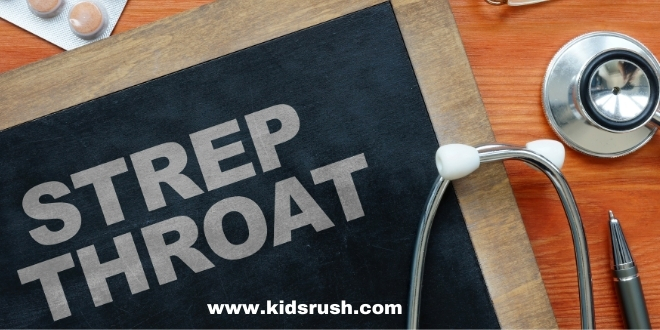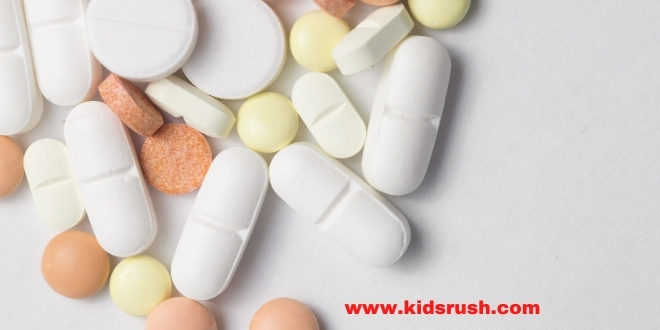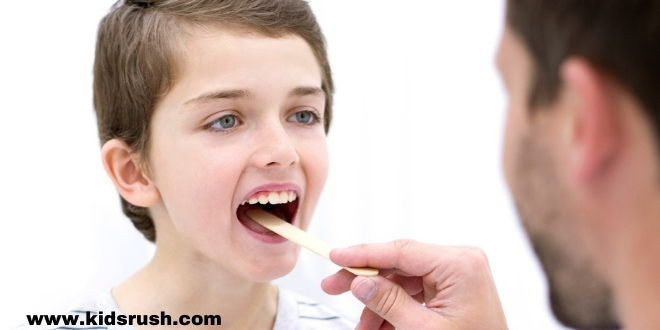Strep throat in children:
What is strep throat?
It is a throat infection caused by a bacteria, or germ, called strep. The main symptoms of the infection are fever and sore throat. Strep throat is common in children between 4 and 8 years of age and is rare in children younger than 2 years. A type of pharyngitis caused by group A beta-hemolytic streptococcus (GABHS) can cause complications in other parts of the body. Other forms of strep throat do not cause these complications.
Signs and symptoms

- sore throat
- fever
- your child may refuse to eat or drink because of pain
- your child may have trouble swallowing
- redness and swelling of the tonsils, in some cases with a yellowish-white coating
Some children may have other symptoms such as headache, nausea, vomiting, abdominal, and muscle pain.
The symptoms of strep throat are similar to a sore throat caused by a virus or other illnesses. That is why the health care provider must examine your child to identify the true cause.
Read Also: Dengue in children: symptoms, causes, and treatments
What can the doctor do for strep throat?
Jaw swab
To find the cause of your child’s sore throat, the doctor will use a swab to take a sample of the discharge from the throat (culture). To do the culture, the doctor will rub a cotton swab, which is a toothpick, with a piece of cotton at the end, the sides, and the bottom of your child’s throat. The swab is then tested to diagnose whether it is a Group A (strep) infection.
In some clinics, a rapid test is used to identify strep. This test is useful only when it gives a positive result. When it tests negative, it does not help to rule out the possibility of strep throat.
Antibiotics

Although strep throat can get better without medication, an infection caused by GABHS can lead to complications if left untreated. If the culture is positive, that is, it indicates the presence of GABHS, the doctor will prescribe antibiotics orally (by mouth). Other forms of strep throat do not require treatment with antibiotics.
Read Also: What are the causes of prematurity?
Caring for your child at home
Control fever and complete treatment with antibiotics
Fever and sore throat generally improve within 3 days after antibiotic treatment is started It is important to complete treatment to avoid recurrence of infection, antibiotic resistance, and complications of the disease.
To treat fever or pain, you can use acetaminophen (Tylenol, Tempra, or other brands) or ibuprofen (Motrin, Advil, or other brands). DO NOT give ASA (acetylsalicylic acid or aspirin) to your child.
Offer soft foods and a liquid diet
Eating and drinking can be painful for a child with strep throat. Here are some tips to make things easier for your child:
- If she has trouble swallowing, offer soft foods that are easy to swallow, such as soup, ice cream, dessert, or yogurt.
- You should offer a large number of fluids. You may find it helpful to use a straw or cup with a lid
- If your child is above 1 year old, try giving 1 to 2 teaspoons (5 to 10 ml) of purified honey to calm the throat and reduce a cough.
- Older children can try gargling with lukewarm saltwater
- Older children and teens can feel some relief when they suck on ice chips and lozenges. This is not suitable for young children, as they can choke.
Reduce the spread of infection
Strep throat can easily spread to other family members and classmates. Any child or adult who lives in the same house and has the same symptoms within 5 days should have a jaw swab. From 24 hours after starting the antibiotic treatment, the child is no longer contagious. This means that the child will be able to return to school after 1 day if he feels better.
Other tips to avoid spreading the infection:
- Wash your hands with warm water and soap or you can apply an alcohol-based hand sanitizer
- The child should not share glasses or utensils with friends or colleagues
- Make sure to wash all utensils and glasses your child uses in hot soapy water or a dishwasher.
- Sneezing covering the mouth with the crook of the elbow, or coughing covering the mouth and nose
- Avoid kissing and facial contact
Complications
Throat abscess
Strep throat can lead to the development of an abscess in the throat (accumulation of pus in the tissues). Symptoms include high fever, hoarse voice, difficulty opening the mouth, increased salivation and drooling, and swelling in the neck. If these symptoms occur, seek medical attention.
Other complications
While rare, another complication is rheumatic fever, a condition that can involve the skin, joints, heart, and brain. Other complications are inflammation of the joints (arthritis) and inflammation of the kidneys.
Treatment of strep throat with antibiotics almost always prevents these complications.
When to call the pediatrician

Contact your pediatrician if:
- fever does not go down within 3 days once antibiotics are started
- you have other concerns or questions
- the child starts to have a fever, a rash, swollen joints, or shortness of breath
Take it to the nearest emergency room, or call 911 if necessary, if your child:
- cannot drink or eat and are becoming dehydrated
- have trouble breathing
- he seems to be very sick
Key points
- The main indications of strep throat are sore throat and temperature.
- If you suspect that your child may have this disease, take him to the pediatrician
- Complete antibiotic treatment is essential to prevent relapse and complications
- For pain relief, offer soft foods and cold drinks, as well as pain relievers
- Make sure that all family members or close people who have the same symptoms, see the doctor
